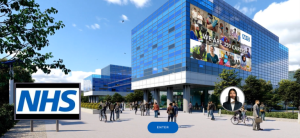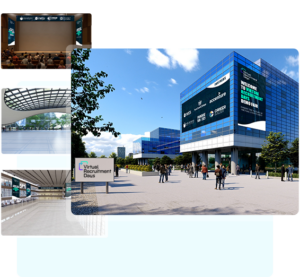Ever since the rise in virtual events, event planners have looked for ways to engage and hook their online audience. They wish to gather people in a safe space that offers a life-like experience. For that matter, a virtual tour is created to engage the audience and allow them to explore the space in a walk mode. From stepping onto the landing page to exploring the reception, halls, lobbies and webinar rooms, the virtual event is in itself a VR experience. It allows the audience to remotely experience the location while sitting comfortably on their couch. With virtual tours, the students get to explore their dream institute, job applicants visit the corporate building, and potential buyers learn about the specifications of the new product line.
Over the years, we have witnessed virtual tours gaining popularity in various fields of life. Be it the gaming industry, architecture or the event industry, VR has undoubtedly hooked audiences to the screens. However, now, the virtual event industry is greatly benefiting from virtual tours. For example, if you are hosting a university open day, the virtual platform allows you to immerse prospective students in an engaging tour of the campus building. This is now considered a sustainable choice as it minimizes the need for travelling and saves us from other environmental impacts. So if you wish to stay competitive within the event industry, then all you need to do is create immersive 3D tours for your audience. Here’s why you should choose a 3D virtual events platform.
Now let us first dig into virtual tours and how they benefit our event industry.
What is a Virtual Tour?
A virtual tour is composed of a series of 360-degree still images or videos. It allows you to be digitally present at a location and individually explore it as if you are there. Basically, a virtual tour is the video animation of any space, property, or product that immerses viewers in the visual experience. It is a realistic display of an environment with buildings, moving avatars, product descriptions, lighting, sounds and more.
Wearing a headset VR device, the viewer is entrapped in a virtual environment that is a replica of the physical world. For virtual events, the complete venue is visualized for the audience to interact with the space, connect with their fellow audience, and participate in the event. There are several types of virtual tours that are known to be highly interactive and immersive.
- Video tours
- Virtual space exploration
- 360-degree panoramic tours
- Floorplan tours
- 3D product tours
Today, virtual tours are used in many fields, such as entertainment, education, advertising, recreation, etc.
How Does a Virtual Tour Work?
A virtual tour primarily immerses viewers in a realistic display of a real-life environment. Once viewers click on the video tour, it walks them around, engaging in photorealistic visuals. It not only helps you display a physical space but also supports you through presenting a new product before the world.
Take, for instance, you wish to launch a new product to a global audience. By hosting a virtual trade show, you can display complete product demo tour videos to educate and inform the audience. This way, your audience will learn about the products they are to invest in and make wise purchase decisions. Thus, virtual tours are a plus for event organizers aiming to create an engaging experience for their audience.
Benefits of Virtual Tours for the Event Industry
Today, the event industry is facilitating event planners, organizers and hosts to create a 3D reality experience for their audience. Instead of boring the audience with still images, a virtual tour allows attendees to see the space from multiple angles. Here’s a guide for event planners on how virtual tours are essential and beneficial.
Complete Campus Tours
When hosting a university open day, the virtual event industry welcomes the audience in a 3D-animated environment. Once the prospective student has thoroughly learned about the campus facilities, it is time for them to experience the campus building virtually. Basically, a complete virtual tour of the campus is created where students can literally discover the university from the main gate to the classroom and hostel. Here, students get to experience campus life virtually as if they are actually walking around the campus. Moreover, the moving animated avatars all over the place add a hint of realism to the virtual environment.
These virtual tours may be displayed at the exhibitor booths, live presentations, or webinars where attendees immerse themselves in the live experience. It is considered the perfect marketing collateral that convinces students to apply for the available programs. Altogether, virtual tours of the campus benefit the event industry as;
- Prospective students access the campus tours from the comfort of their homes
- Remote students are well guided by the tours with no need to travel down to a physical location
- Students thoroughly learn about the building, facilities, departments, faculty and administration
- Guided audio helps students follow the lead of the tour guide
- Educational institutes receive double the number of admission applications
- Virtual tours guide students, parents and guardians alike
- Ariel view speaks about the architecture and grandiosity of the institution
- Students get a peek of life at the campus they are to get in
- Each exhibitor booth displays departmental-focused tours to assist students with the available programs
- Remote students learn about the hostel life and the available facilities for hostelites
All-in-all, virtual tours elevate the experience for an online audience. Students remotely learn about their dream college or university and apply for open degrees. Here’s how you can show off campus facilities with a virtual open day.
Detailed Product Descriptions
Virtual product tours are an excellent way for a startup business to make flashing sales of its new product line. Firstly, you need to host a virtual product launch event at a virtual events platform that fully supports 3D product tours. Once the attendees explore the products they are interested in, they decide which products suit them best. In fact, the interactive features of virtual tours allow them to easily witness the walkthrough product animations, explore features, and zoom into the product’s specifications. Similarly, at a virtual sales event, a complete product catalogue is installed at the exhibitor booths. It is for the attendees to visualize, customize and experience the product lines.
Essentially, it is a digital experience that builds buyer confidence and ensures product sales by 70%. Here, the B2B or B2C deals happen online in real-time, saving buyers the time and expense of visiting the outlets.
Learn more about how to plan and execute B2B virtual events.
Immersive Office Space
Just like that, virtual tours have made the online experience a walk to remember. If you are an organization aiming to expand the workforce around the world, then virtual job fairs are the way to do it right. But, when hosting remote applicants, you must take practical steps to familiarize the candidates with the office building and facilities. So, virtual tours of the office space work wonder when it comes to convincing applicants to work for your organization. It works effectively for both the on-site and remote workforce. With a virtual tour, you can present your entire office space in a 3D animated environment with moving avatars to add realism to the scene. Check out our complete guide to virtual office.
Interestingly, these guided tours can take attendees on a ride through the corporate building moving from lobbies to halls and meeting rooms. Candidates can explore the facilities using the guided buttons installed at the animated walkthroughs. It allows attendees to feel included and more confident about the organization they are to work for. Lastly, this helps secure 100% of job applications with 50% on-the-spot hirings. Overall, virtual office tours benefit the event industry with the following:
- Familiarizes candidates with the complete office building exterior and interior
- Assists remote candidates with their decisions to work for the organization
- Builds stronger brand image for the organization
- Helps organizations put their best foot forward with a virtual tour
- Fully immerses candidates in the architecture, building and its facilities
- Guided buttons help candidates personally engage with 3D animated walkthroughs
- Walk mode allows candidates to explore the space as they like
- Global attendees access the tours from anywhere in the world
- Eases the process of employee hiring for the HR
Thus, a virtual tour facilitates the process of digital interaction among humans. Without travelling down to a location, your virtual event attendees experience a real-life space from afar.
Final Thoughts
Virtual Days Platform takes this opportunity to explain the importance of virtual tours for the event industry. Not only does this benefit a remote audience, but it also supports organizations by cultivating global brand recognition. With virtual tours, you will surely enhance the audience’s virtual experience at your B2B and B2C events. So when it comes to scoring potential candidates, workforce or sales, virtual tours help you succeed.
Get in touch with us today to check out our features, tools and facilities. Let us begin planning your next big virtual event that leaves your competitors in awe.






